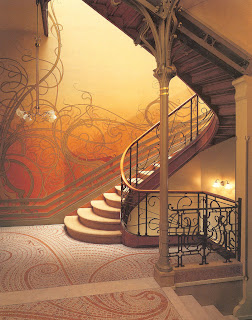The origins of Art Nouveau are found in the resistance of William Morris to the cluttered compositions and the revival tendencies of the Victorian era and his theoretical approaches that helped initiate the Arts and crafts movement.
The movement was influenced by the Symbolists most obviously in their shared preference for exotic detail, as well as by Celtic and Japanese art. Art Nouveau flourished in Britain with its progressive Arts and Crafts movement, but was highly successful all around the world.
At the end of the nineteenth century, Art Nouveau transformed neighborhoods and whole towns around the world into remarkable examples of the contemporary, vital art of the age. Even though its style was at its zenith for just a decade, Art Nouveau permeated a wide range of the arts. Jewelery, book design, glasswork, and architecture all bore the imprint of a style that was informed by High Victorian design and craftwork, including textiles and wrought iron. Even Japanese wood-block prints inspired the development of Art Nouveau, as did the artistic traditions of the local cultures in which the genre took root.
The leading exponents included the illustrators Aubrey Beardsley and Walter Crane in England; the architects Henry van de Velde and Victor Horta in Belgium; the jewelery designer René Lalique in France; the painter Gustav Klimt in Austria; the architect Antonio Gaudí in Spain; and the glassware designer Louis C. Tiffany and the architect Louis Sullivan in the United States. Its most common themes were symbolic and frequently erotic and the movement, despite not lasting beyond 1914 was important in terms of the development of abstract art.

Furthur information:
A really informative exhibit with audio to take you through the Art Nouveau period:
http://www.nga.gov/feature/nouveau/exhibit_audio.shtm
http://artnouveau.pagesperso-orange.fr/en/index.htm
A highly functional flash site displaying the work of Klimt:
http://www.iklimt.com/

5 comments:
Very informative Mauro, Thank you.
I really like the exhibit site. MN
This is the time period that items started to get very expensive, and the artisan had to pay attention to detail excuslively and mathematically. This is the reason why architects have to take calculus and physics as part of there training.
I think Art Nouveau is quickly becoming one of my all-time favorite art periods (though, not my favorite to spell). I didn't realize exactly how much it had influenced the art of the psychedelic era in America! The ornate design of everything in the original time period is just phenomenal to look at. I love that it was so strongly influenced by nature, but the representation of it wasn't obvious. They mixed the curvilinear aspects of art with modern materials like cast iron, which is brilliant in my opinion.
I think that I would like to research on my own a bit more about both the Art Nouveau period and its resurgence in the 1960's. I just think it's amazing how the original style was so ahead of its time. It's sad that this beautiful art movement was yet another thing destroyed by the war.
Art Nouveau, a new style in the visual arts and architecture that developed in Europe and North America at the end of the nineteenth century, was established as the first new decorative style of the twentieth century at the 1900 World’s Fair in Paris. This was a concerted attempt to create an international style based on decoration, and was in many ways a response to the Industrial Revolution. Artists condemned the poor quality of mass-produced machine-made goods and attempted to apply a high standard of craftsmanship to everyday objects. They believed all the arts (jewelry, furniture, buildings, textiles) should work in harmony to create a total work of art.
So it looks like as of May 14th, the Worcester Art Museum will have on display that first image featured in this blog entry, "JOB" by Alphonse Mucha.
Here's info about the exhibit:
http://www.worcesterart.org/Exhibitions/french_woman.html
Post a Comment